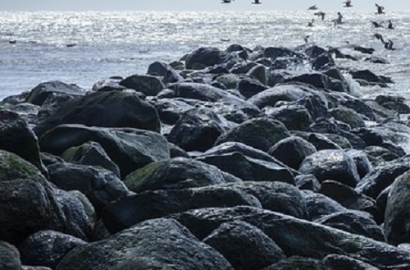
This compressed air energy storage would work by using electricity from renewables to power a motor that generates compressed air. This air would be stored at high pressure in the pores found in sandstone, using a deep well drilled into the rock. The pressurized air could later be released to drive a turbine to generate large amounts of electricity.
Using the technique on a large scale could store enough compressed air to meet the UK’s electricity needs during winter, when demand is highest, the study found.
The approach could help deliver steady and reliable supplies of energy from renewable sources such as wind and tidal turbines.
Engineers and geoscientists from the Universities of Edinburgh and Strathclyde used mathematical models to assess the potential of the process, called compressed air energy storage (CAES).
The team then predicted the UK’s storage capacity by combining these estimates with a database of geological formations in the North Sea.
Porous rocks beneath UK waters could store about one and a half times the UK’s typical electricity demand for January and February, they found.
During times of energy shortage, the pressurized air would be released from the well, powering a turbine to generate electricity that is fed into the grid.
Locating wells close to sources of renewable energy – such as offshore wind turbines – would make the process more efficient, cheaper and reduce the amount of undersea cables required, the team says.
Dr. Julien Mouli-Castillo, of the University of Edinburgh's School of GeoSciences, who led the study, said, “This method could make it possible to store renewable energy produced in the summer for those chilly winter nights. It can provide a viable, though expensive, option to ensure the UK’s renewable electricity supply is resilient between seasons. More research could help to refine the process and bring costs down.”
The study is published in the journal Nature Energy. It was funded by the Engineering and Physical Science Research Council, Scottish Funding Council, and the Energy Technology Partnership.

